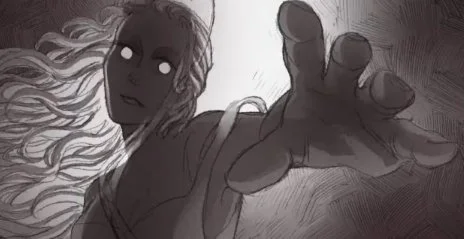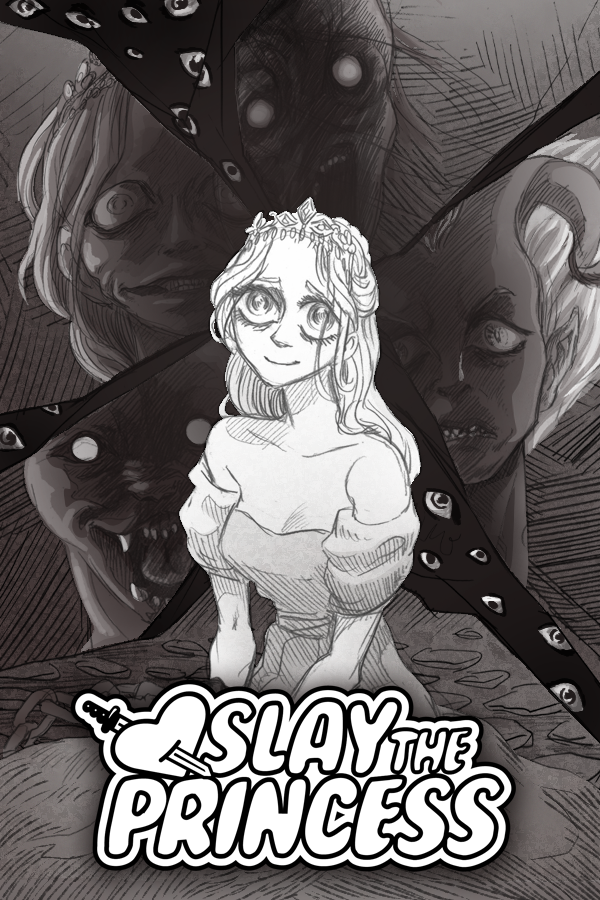Slay the Princess: Morality, Identity, and Cosmic Existentialism
“You're on a path in the woods, and at the end of that path is a cabin. And in the basement of that cabin is a Princess. You're here to slay her. If you don't, it will be the end of the world.” - these words from the opening dialogue of Slay the Princess are forever etched into my mind.
Black Tabby Games’ Slay the Princess isn’t just a game, it’s a psychological labyrinth that plunges players into the depths of moral ambiguity, fragmented identity, and existential dread. Its narrative, which begins with the simple directive to slay a princess to save the world, spirals into a deeply layered exploration of free will, perception, and the cyclical nature of creation and destruction.
Through its recursive structure, shifting characters, and unreliable narrators, Slay the Princess constructs an intricate metaphor for the human experience, forcing players to confront their assumptions about morality, identity, and the search for meaning in an ever-changing world.
This article contains SPOILERS so Check Out Slay the Princess first!
The Psychological Weight of Loops and Eternal Return
The cyclical nature of Slay the Princess aligns with the concept of eternal return, a philosophical idea popularized by Friedrich Nietzsche, which suggests that life and its events recur infinitely. This repetition, where the protagonist is reset after each death with fragmented memories, mirrors the psychological experience of struggling with unresolved trauma. The player, like the protagonist, must make sense of a reality where actions are never final and outcomes are always fluid.
The loop's design triggers feelings of learned helplessness; a psychological state where repeated exposure to uncontrollable events leads to a sense of resignation. However, the player’s ability to alter small details in subsequent iterations also evokes cognitive reframing, encouraging them to see the same situation through new perspectives. Each reset is not just a new opportunity but a chance to rewrite the narrative, both for the protagonist and for the players interpreting the story.
The Shifting Princess: Identity as Perception
The Princess’s transformation across loops, appearing as benevolent, monstrous, or fragmented embodies the psychological concept of identity as fluid and relational. In Slay the Princess, the Princess is not a fixed entity but a projection shaped by the Hero’s actions and the perspectives imposed upon her by the Narrator, the Hero, and the player.
This phenomenon can be understood through the lens of social identity theory and the looking-glass self:
The Princess’s identity shifts because she is perceived differently in each loop, much as individuals in real life internalize and reflect the perceptions of others.
Her monstrous forms reflect the shadow self, a term from Jungian psychology describing the repressed and feared aspects of one's psyche.
Through the Princess, the game explores how identity is rarely fixed, it’s a malleable construct that is constantly reshaped by external pressures and internal struggles. The player’s choices don’t just define the Princess; they reveal hidden facets of the Hero’s own identity and morality.
The Hero as the Long Quiet: Embodying Cosmic Dualities
The reveal that the Hero is the Long Quiet, a nascent god and the embodiment of stasis reframes the narrative as a cosmic allegory. This duality between the Hero (stasis) and the Princess (change) parallels existential debates about the human condition:
Stasis represents safety, order, and preservation at the cost of growth.
Change embodies creation, destruction, and renewal, but at the risk of chaos and loss.
The psychological tension between these forces is mirrored in the Hero’s choices:
Choosing to permanently slay the Princess preserves the current universe but halts evolution.
Aligning with the Shifting Mound invites destruction but promises rebirth.
This dichotomy resonates with the existentialist idea that individuals must find meaning in a world governed by opposing forces of chaos and order. The Hero’s journey becomes a metaphor for the existential struggle to reconcile life’s transience with the desire for permanence.
The Narrator: Unreliable Guides and Cognitive Dissonance
The Narrator in Slay the Princess is a classic example of an unreliable narrator, creating cognitive dissonance for the player by presenting conflicting information and motives. Initially portrayed as an omniscient guide, the Narrator’s true nature as a mortal Echo with his own fears and biases is gradually revealed.
Psychologically, this reflects the human tendency to trust authority figures and the subsequent discomfort when those figures are unmasked as flawed or self-serving. The Narrator’s eventual plea for the Hero to preserve the universe echoes real-world struggles with mortality salience; the awareness of death and the lengths people go to avoid or deny it.
Voices and Internal Conflict
The Hero’s internal Voices, separate from the Narrator, add another layer of psychological complexity. These Voices can be interpreted as the subpersonalities described in internal family systems (IFS) therapy, which posits that individuals consist of multiple internal "parts" with distinct roles and perspectives.
The Voices embody competing instincts, reason, fear, defiance each vying for control of the Hero’s actions.
Their presence mirrors the internal dialogues individuals experience when faced with morally complex decisions.
By giving these inner voices tangible form, Slay the Princess externalizes the internal conflicts that arise when grappling with profound ethical dilemmas.
Moral Ambiguity and the Weight of Choice
Every ending in Slay the Princess leaves players with lingering questions rather than clear resolutions. Whether the Hero preserves the current universe, ushers in a new one, or escapes the loop with the Princess, the game avoids moral absolutism.
This ambiguity reflects real-world ethical dilemmas where no choice is wholly good or bad. From a psychological perspective, the game forces players to confront:
Moral relativism, where actions are judged based on context rather than universal principles.
The paradox of choice, where more options can lead to greater anxiety and regret.
In the end, players must grapple with the consequences of their decisions not as definitive answers but as reflections of their values and priorities.
The Long Quiet and the Shifting Mound: A Cosmic Allegory
The relationship between the Long Quiet and the Shifting Mound transcends their roles as protagonist and antagonist, symbolizing the interplay between stasis and change, order and chaos, death and rebirth. Their final moments, where they may either coexist as gods or reject their divine roles, emphasize the human yearning for connection and meaning in an indifferent universe.
This interplay evokes existentialist themes, where the ultimate meaning of life is not handed down by a higher power but created through individual choice and connection. Whether the Hero and Princess embrace godhood or choose to face an uncertain future together, their story underscores the resilience of the human spirit in the face of cosmic insignificance.
Simply Put: Slay the Princess as a Mirror of the Human Psyche
Slay the Princess is more than a game, it’s a psychological odyssey that holds a mirror to the player’s mind. By blending moral complexity, existential themes, and a narrative that reshapes itself with every loop, the game invites players to explore the depths of their own identity, values, and fears.
Its cyclical structure and shifting characters echo the eternal struggles of human existence: the search for meaning, the fear of change, and the delicate balance between creation and destruction. As you guide the Hero through the path in the woods, the cabin, and face the basement door of that cabin, you embark on a journey not just to the Princess but across an existential labyrinth of morality and identity.
Check Out: Slay the Princess






Explore how Slay the Princess subverts the stereotypical princess trope, drawing on psychological theories and peer-reviewed sources to analyse its impact on perceptions of gender and agency.